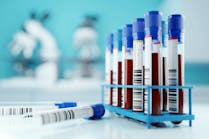Pharmacogenomics: How genetic testing is making therapeutics safer and more effective
Pharmacogenomics was one of the earliest success stories of the genome era, and today serves as a foundation for the concept of precision medicine. From companion diagnostics to individual drug metabolism profiles, knowledge of a patient’s genetic variation can be critical for guiding the selection or dosing of a therapeutic. Indeed, genetic testing has allowed the pharmaceutical industry to streamline drug development while delivering therapeutics with better efficacy and reduced adverse events. This trend has also led to an increase in the types and number of genetic tests that must be tracked and made available by clinical lab professionals.
Two kinds of genetic tests have shown great utility in this area: companion diagnostics, or tests paired with a drug to ensure its use in patients who are most likely to benefit; and drug metabolism tests, which help identify patients who may not be able to tolerate a certain drug or who require different dosing for effective treatment. Together, these tests help physicians choose the best therapeutic option for a specific patient, maximizing effectiveness while minimizing the risk of severe adverse reactions.
In this article, we look at the remarkable rise of companion diagnostics and drug metabolism tests, as well as what to expect from this field in the coming years.
Companion diagnostics
In 1998, the U.S. Food and Drug Administration (FDA) approved Herceptin, the first therapeutic tied to a particular genetic biomarker determined by a companion diagnostic test. Since then, the march toward mainstream companion diagnostics has been slow but steady. Today, some two dozen FDA-cleared companion diagnostics are mandatory for the prescription of certain drugs, while nearly 140 drugs have labels recommending (but not requiring) pharmacogenomic testing.1
According to an analysis from the Personalized Medicine Coalition, a nonprofit advocacy group, 28 percent of the new drugs approved by the FDA last year could be classified as “personalized medicine”— that is, their labels indicate that optimal patient response is linked to the use of a diagnostic test.2 While the earliest companion diagnostics were targeted at cancer, where the genetic profile of a tumor can point to the most-likely-to-succeed therapeutic, their use has since broadened to include drugs for infectious diseases, cystic fibrosis, and several other disease areas.3
Companion diagnostics offer several advantages to pharmaceutical companies beyond safer and more effective medications for patients. Clinical trials for targeted treatments can be smaller, which makes them less expensive and faster at generating results. These tests can also be used to rescue promising investigational compounds that would otherwise be shelved for not working broadly across all patients; with the right biomarker and a companion test, these drug candidates can be safely ushered through clinical trials by delivering them only to an optimally defined patient group. In what is widely acknowledged to be the post-blockbuster-drug era, pharma and biotech companies have found a successful alternative in spending less money to develop treatments that work for high-value niche indications.
Drug metabolism testing
Many genetic tests analyze patients for their ability to process a particular drug or class of drugs. This testing was enabled by the discovery that the cytochrome P450 genes encode enzymes responsible for metabolizing as much as 80 percent of currently available therapeutics. These enzymes—CYP2D6, CYP2C19, CYP2C9, CYP3A4, and CYP3A5—mostly occur in the liver, where they handle the breakdown of drugs and clear them from the system. CYP2D6 alone is thought to metabolize up to 25 percent of therapeutics, including pain medications, cardiovascular drugs, and anti-psychotics.
The genes encoding these enzymes are highly variable among individuals, and extensive studies have determined that patients with specific genotypes are more likely to metabolize (and therefore respond well to) certain drugs, while patients with other genotypes may see little or no benefit because their bodies do not process the therapeutics. Based on this information, many companies have developed genetic tests to reveal a patient’s metabolism profile and guide therapy selection.
The CYP2D6 gene is particularly prone to variation, with significant fluctuations across populations and more complex variant events, such as gene deletions and duplications. Clinical researchers continue to study this gene, deploying the most sophisticated DNA sequencing and analysis technologies to characterize all possible types of variation for a better understanding of how these differences contribute to a person’s ability to tolerate and metabolize medications.
Even as our understanding of drug metabolism genotypes continues to evolve, current tests are already making a tremendous clinical difference. They are useful not only in helping physicians avoid treatments that are not likely to work for a patient, but also in selecting the appropriate dose of a treatment based on how rapidly that patient is expected to metabolize and clear the drug. This information has proven to be particularly important for optimal dosing of pain medications, for example, as well as for blood thinners like warfarin that may be harmful in higher-than-necessary doses.
Looking ahead
The rise of pharmacogenomic testing has been both a boon and a challenge for clinical laboratories, which often need to implement new diagnostic instruments in addition to validating and incorporating these assays into their offerings. As more types of genetic variation are understood and linked to drug response or metabolism—such as structural variants, epigenetic patterns, and distantly linked variants—these tests promise to become more complex as well. Clinical lab professionals will need to keep up with this rapidly developing field and be trained on new technologies to ensure that their teams stay at the cutting edge of molecular diagnostics.
In the future, evidence suggests that companion diagnostics will become far more common. Perhaps in the long term it will even displace one-size-fits-all drugs as the norm in prescription medication. According to a recent analysis by the Tufts Center for the Study of Drug Development, pharmaceutical companies are still ramping up their investment in diagnostic-targeted therapies. The study found that these firms anticipate allocating 33 percent more funding to personalized medicine over the next five years, and expect to develop nearly 70 percent more personalized therapeutics during that time.4 The study also reported that identifying biomarkers and developing the diagnostics are still considered major scientific challenges within the pharma/biotech industry. With a new diagnostic test needed for each targeted therapeutic in development, this represents a considerable hurdle.
Drug metabolism testing, on the other hand, will likely become more sophisticated as scientists learn more about genetic variation within the CYP genes—but the beauty of it is that a single test result can aid in the prescription and dosing of numerous drugs. Currently, this kind of information is even available through some consumer-oriented genetic testing services, making it more likely that patients will have broad access to their own drug metabolism profiles in the near future. (It’s worth noting that this makes it even more important for clinical labs to provide high-quality genetic testing for drug metabolism to confirm or dispute the data patients may have gathered through less rigorous services before results are used to make medical decisions.)
Genetic testing has proven essential for the rise of precision medicine. With continued investment from pharma companies and diagnostic developers, as well as ongoing training among clinical lab professionals, there is good reason to believe that we are well on our way to a new era of medicine that does away with population averages and instead uses genetic and other molecular information to tailor treatment for each patient.
REFERENCES
- List of Cleared or Approved Companion Diagnostic Devices. FDA. http://www.fda.gov/MedicalDevices/ProductsandMedicalProcedures/InVitroDiagnostics/ucm301431.htm.
- Personalized Medicine by the Numbers. Personalized Medicine Coalition. http://www.personalizedmedicinecoalition.org/Userfiles/PMC-Corporate/file/pmc_personalized_medicine_by_the_numbers.pdf.
- Personalized Medicine Coalition. 2015 Progress Report: Personalized Medicine at FDA. http://www.personalizedmedicinecoalition.org/Userfiles/PMC-Corporate/file/2015_Progress_Report_PM_at_FDA1.pdf.
- Tufts Center for the Study of Drug Development. Personalized medicine gains traction but still faces multiple challenges. Tufts CSDD Impact Reports (Single Issue). May/June 2015, Vol. 17 No. 3.
Sherry Dunbar, PhD, serves as Senior Director of Global Scientific Affairs at Luminex Corp., where she oversees scientific and research activities related to the company’s genetic testing and infectious diseases molecular diagnostic portfolios.





